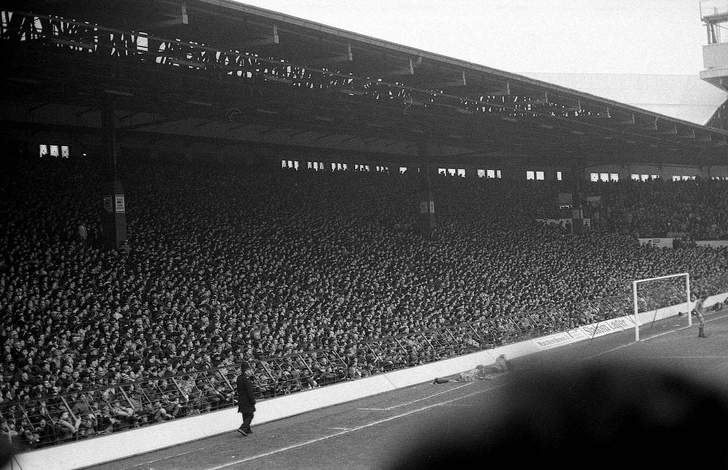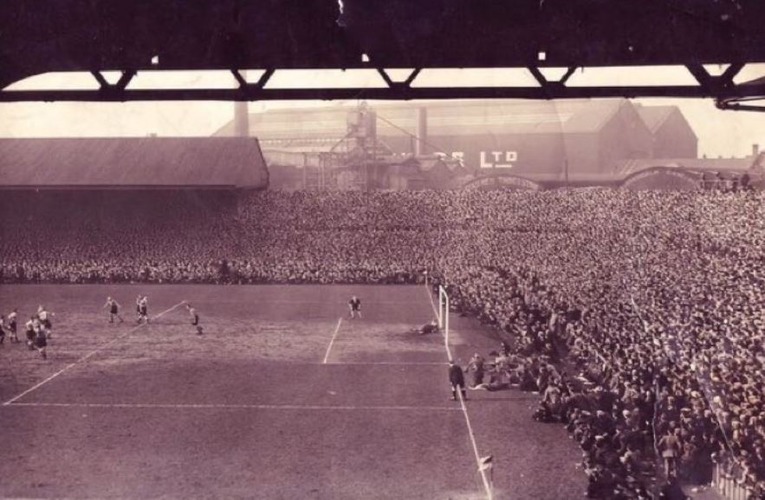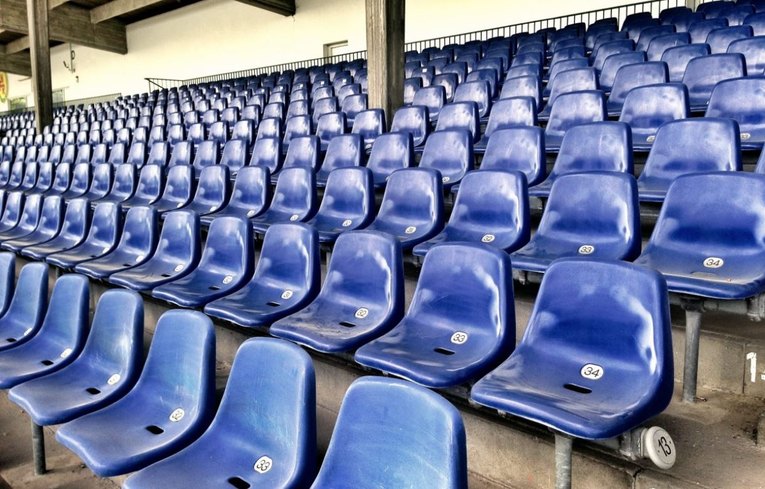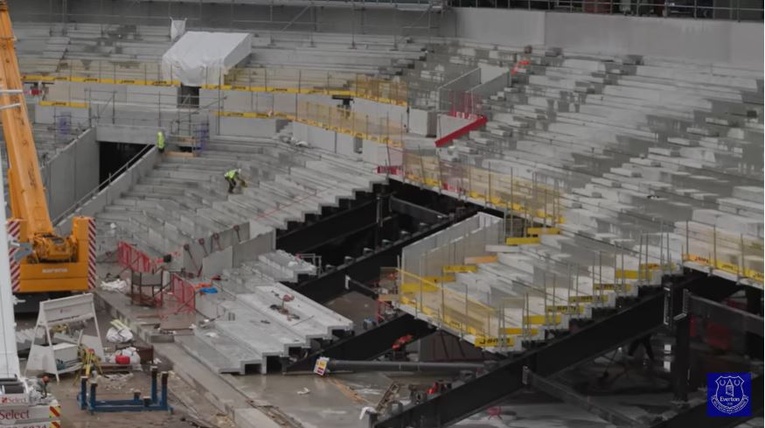
More than anything else, football is a spectator sport. If there’s no one there to watch the game taking place then it’s just a load of people kicking a ball around and being really competitive.
In the past some of the sport’s most iconic venues set incredible attendance records, with more than 60,000 people often turning up to watch matches being played.
That’s changed dramatically in recent times, for a host of reasons. But what are those reasons? What has impacted attendances at football matches? What do the trends look like for the future?
We’re going to explore how the way we watch the beautiful game has changed and what is likely to happen moving forward.
Premier League Stadium Record Attendances
| Stadium | Attendance | Match |
|---|---|---|
| Stamford Bridge | 82,905 | Cheslea v Arsenal (1935) |
| Goodison Park | 78,299 | Everton v Liverpool (1948) |
| Old Trafford | 76,962 | Wolves vs Grimsby Town (1939) |
| Villa Park | 76,588 | Aston Villa v Derby County (1946) |
| St James' Park | 68,386 | Newcastle v Chelsea (1930) |
| Bramall Lane | 68,287 | Sheffield United v Leeds (1936) |
| London Stadium | 62,449 | West Ham vs Brighton (Aug 2022) |
| Tottenham Hotspur Stadium | 62,027 | Tottenham v Arsenal (May 2022) |
| Anfield | 61,905 | Liverpool v Wolves (1952) |
| Molineux | 61,315 | Wolves v Liverpool (1939) |
| The Emirates | 60,383 | Arsenal v Wolves (November 2019) |
| Turf Moor | 54,755 | Burnley v Huddersfield (1924) |
| The Etihad | 54,693 | Manchester City v Leicester City (2016) |
| Selhurst Park | 51,801 | Crystal Palace v Burnley (1979) |
| The City Ground | 49,946 | Notts Forest v Man United (1967) |
| Craven Cottage | 49,335 | Fulham v Milwall Dockers (1938) |
| Falmer Stadium | 31,746 | Brighton v Chelsea (2022) |
| Kenilworth Road | 30,069 | Luton Town v Blackpool (1959) |
| Vitality Stadium | 28,799 | Man U v Bournemouth (1957) |
| Community Stadium | 17,163 | Brentford-Liverpool 2nd January 2023 |
Record Attendances in Other Leagues
Championship
| Stadium | Attendance | Match |
|---|---|---|
| Hillsborough | 72,841 | Sheffield Wed v Man City (1934) |
| St Andrew’s | 67,341 | Birmingham v Everton (1939) |
| The Hawthorns | 64,815 | West Brom v Arsenal (1937) |
| Ewood Park | 61,783 | Blackburn v Bolton (1929) |
| Elland Road | 57,892 | Leeds v Sunderland (1967) |
| The Stadium Of Light | 48,353 | Sunderland v Liverpool (2002) |
| Carrow Road | 43,984 | Norwich City v Leicester (1963) |
| Home Park | 43,596 | Plymouth v Aston Villa (1936) |
| Ashton Gate | 43,335 | Bristol City v Preston (1935) |
| Deepdale | 42,684 | Preston v Arsenal (1938) |
| Portman Road | 38,010 | Ipswich v Leeds (1975) |
| Loftus Road | 35,353 | QPR v Leeds United (1974) |
| Riverside Stadium | 35,000 | England v Slovakia (2004) |
| Vicarage Road | 34,099 | Watford v Man United (1969) |
| Cardiff City Stadium | 33,280 | Wales v Belgium (2015) |
| St Mary’s | 32,363 | Southampton v Coventry (2012) |
| King Power Stadium | 32,241 | Leicester v Sunderland (2015) |
| Coventry Building Society Arena | 32,128 | England/Italy & Belgium/South Korea (19th Feb 2023) |
| Bet365 Stadium | 30,022 | Stoke vs Evertom (17/03/2018) |
| The MKM Stadium | 25,280 | England v Netherlands U21 (2004) |
| John Smiths Stadium | 24,169 | Huddersfield v West Brom (2017) |
| Liberty Stadium | 20,972 | Swansea City v Liverpool (2016) |
| The Den | 20,093 | Millwall v Arsenal (1994) |
| New York Stadium | 11,758 | Rotherham v Sheffield Utd (2013) |
League One
| Stadium | Attendance | Match |
|---|---|---|
| The Valley | 75,031 | Charlton v Aston Villa (1938) |
| Fratton Park | 51,385 | Portsmouth v Derby (1949) |
| Vale Park | 49,768 | Port Vale v Aston Villa (1960) |
| Oakwell Stadium | 40,255 | Barnsley v Stoke City (1936) |
| Bloomfield Road | 38,098 | Blackpool v Wolves (1955) |
| Brisbane Road | 34,345 | Leyton Orient v West Ham (1964) |
| Pride Park | 33,598 | England v Mexico (2001) |
| Weston Homes London Road | 30,096 | Peterborough v Swansea (1965) |
| The University of Bolton Stadium | 28,353 | Bolton v Leicester (2003) |
| Brunton Park | 27,500 | Carlisle v Birmingham (1957) |
| DW Stadium | 25,133 | Wigan v Man United (2008) |
| Madjeski Stadium | 24,184 | Reading v Everton (2012) |
| Sincil Bank | 23,196 | Lincoln City v Derby County (1967) |
| St James Park | 20,984 | Exeter v Sunderland (1931) |
| Abbey Stadium | 14,000 | Cambridge Utd v Chelsea (1970) |
| Kassam Stadium | 12,243 | Oxford v Leyton Orient (2006) |
| Memorial Stadium | 12,011 | Bristol Rovers v West Brom (2008) |
| New Meadow | 10,210 | Shrewsbury v Chelsea (2014) |
| Adams Park | 10,000 | Wycombe v Chelsea (2005) |
| Whaddon Road | 8,326 | Cheltenham v Reading (1956) |
| Broadhall Way | 8,040 | Stevenage v Newcastle 1998 |
| Sixfields Stadium | 7,664 | Northampton v Luton (2016) |
| Pirelli Stadium | 6,912 | Burton Albion v Oxford (2009) |
| Highbury Stadium | 6,150 | Fleetwood v Rochdale (1965) |
League Two
| Stadium | Attendance | Match |
|---|---|---|
| Meadow Lane | 47,310 | Notts Couty v York City (1955) |
| Valley Parade | 39,146 | Bradford City v Burney (1911) |
| Racecourse Ground | 34,445 | Wrexham v Manchester United (1957) |
| The County Ground | 32,000 | Swindon Town v Arsenal (1972) |
| Blundell Park | 31,651 | Grimsby Town v Wolvers (1937) |
| Stadium mk | 30,048 | Rugby World Cup Fiji vs Uruguay 2015 |
| Edgeley Park | 27,833 | Stockport County v Liverpool (1950) |
| Field Mill One Call Stadium | 24,467 | Mansfield v Notts Forest (1953) |
| Prenton Park | 24,424 | Tranmere v Stoke City (1972) |
| Priestfield Stadium | 23,002 | Gillingham v QPR (1948) |
| Alexandra Stadium | 20,000 | Crewe v Tottenham (1960) |
| Holker Street | 16,874 | Barrow v Swansea Town (1954) |
| Keepmoat Stadium | 15,001 | Doncaster Rovers v Leeds (2008) |
| Gander Green Lane | 14,000 | Sutton United v Leeds United (1969) |
| Banks’s Stadium | 11,049 | Walsall v Rotherham 2004 |
| Community Stadium | 10,064 | Colchester Utd v Norwich (2010) |
| Plough Lane | 9,215 | AFC Wimbledon 3-3 Bolton Wanderers (14/8/21) |
| Rodney Parade | 6,615 | Newport v Havant & Waterlooville (2010) |
| Broadfield Stadium | 5,880 | Crawley Town v Reading 2013 |
| Globe Arena | 5,831 | Morecambe v Sunderland (April 2022) |
| Crown Ground | 5,397 | Accrington v Derby (Jan 2019) |
| The New Lawn Stadium | 4,836 | Forest Green Rovers v Derby County (2009) |
| Peninsula Stadium (Moor Lane) | 4,518 | Salford City v Leeds Utd EFL Cup First Round (2019) |
| EnviroVent Stadium (Wetherby Road) | 3,048 | Harrogate Town v Portsmouth (11/10/2019) |
Scotland
| Stadium | Attendance | Match |
|---|---|---|
| Hampden Park | 149,547 | Scotland v England (1937) |
| Ibrox | 118,567 | Rangers v Celtic (1939) |
| Celtic Park | 83,500 | Celtic v Rangers (1938) |
| Easter Road | 65,860 | Hibernian v Hearts (1950) |
| Tynecastle | 53,396 | Hearts v Rangers (1932) |
| Firhill Stadium | 49,838 | Partick Thistle v Rangers (1922) |
| Pittodrie Stadium | 45,061 | Aberdeen v Hearts (1954) |
| Dens Park | 43,024 | Dundee v Rangers (1953) |
| Rugby Park | 35,995 | Kilmarnock v Rangers (1962) |
| Fir Park | 35,632 | Motherwell v Rangers (1952) |
| Tannadice Park | 28,000 | Dundee United v Barcelona (1966) |
| McDiarmid Park | 10,696 | St. Johnstone v Rangers (1991) |
| Almondvale Stadium | 10,112 | Livingston v Rangers (2001) |
| Victoria Park | 8,000 | Ross County v Rangers (1966) |
| Caledonian Stadium | 7,753 | Inverness CT v Rangers (2008) |
| St Mirren Park | 7,732 | St Mirren v Dundee United (2019) |
| New Douglas Park | 6,007 | Hamilton v Celtic (2015) |
ROW
| Stadium | Attendance | Match |
|---|---|---|
| Santiago Bernabéu | 128,000 | Real Madrid v D Zagreb (1974) |
| Camp Nou | 120,000 | Barcelona v Juventus (1986) |
| Stadio Diego Armando Maradona | 112,365 | SSC Napoli v AC Perugia (1979) |
| Luzhniki Stadium | 102,538 | USSR v Italy (1963) |
| NSC Olimpiyskiy | 100,062 | Dynamo Kiev v Utrecht 1985 |
| Stadio Olimpico | 100,000 | Italy v Hungary (1953) |
| Mercedes-Benz Arena (Stuttgart) | 97,553 | Germany-Switzerland (22nd November 1950) |
| Olympiastadion Berlin | 88,075 | Hertha Berlin v 1 FC Köln (1969) |
| San Siro | 83,381 | Inter Milan v Schalke (1997) |
| Signal Iduna Park | 83,000 | Dortmund v Schalke 2004 |
| Deutsche Bank Park | 81,000 | Eintracht Frankfurt v FK Pirmasens (1959) |
| Stade De France | 80,832 | Guingamp v Rennes (2009) |
| Atatürk Olympic Stadium | 79,414 | Galatasaray v Olympiacos (2002) |
| Veltins-Arena | 77,803 | Germany v United States Ice Hockey 2010 |
| RheinEnergieStadion | 76,000 | Germany v Austria (1953) |
| Allianz Arena | 75,000 | B Munich v Schalke 04 (2015) |
| The Principality Stadium | 74,645 | Wales v Ireland (2009) |
| Wanda Metropolitano | 66,591 | Atlético Madrid v Real Madrid (2017) |
| De Kuip | 65,427 | Feyenoord v Twente (1968) |
| Estadio da Luz | 65,400 | Benfica v Nacional (2003) |
| Stade Velodrome | 65,252 | Marseille v PSG (2017) |
| Puskás Arena | 65,114 | Hungary v Uruguay (2019) |
| Krestovsky Stadium | 64,468 | Russia v Egypt (2018) |
| Stadion Maksimir | 64,138 | NK Zagreb v NK Osijek (1973) |
| Windsor Park | 58,420 | Northern Ireland v England (1956) |
| Stadio Artemio Franchi | 58,271 | Fiorentina v Internazionale (1984) |
| Volksparkstadion | 57,000 | Hamburg v Bayern Munich (2009) |
| Parc Olympique Lyonnais | 56,506 | Lyon v Marseille (2016) |
| Baku National Stadium | 55,000 | Azerbaijan v Norway (2016) |
| The Mestalla | 55,000 | Valencia v Sevilla (2009) |
| Arena Națională | 53,329 | Romania v Netherlands (2012) |
| Estadio de La Cartuja | 52,972 | Celtic v Porto (21/05/2003) |
| Ali Sami Yen Spor Kompleksi Stadium | 52,044 | Galatasaray v Real Madrid (09/04/2013) |
| Estádio do Dragão | 52,000 | Porto v Barcelona (2003) |
| Aviva Stadium | 51,700 | Multiple |
| Friends Arena | 49,967 | Sweden v England (2012) |
| Estadio Jose Alvalade | 49,699 | Sporting CP v Benfica (2016) |
| Parc des Princes | 49,575 | PSG v Waterschei (1983) |
| San Mamés | 49,017 | Athletic Bilbao v Napoli (2014) |
| Stade Pierre-Mauroy | 48,960 | Lille v PSG (2014) |
| Stade Bollaert-Delelis | 48,912 | Lens v Marseille (1992) |
| Stade Geoffroy-Guichard | 48,842 | Saint-Etienne v Lens (1987) |
| Şükrü Saracoğlu Stadium | 45,070 | Fenerbahçe v Galatasaray (2015) |
| Balaídos | 45,000 | Celta Vigo v Getafe (1982) |
| Otkritie Arena | 44,884 | Spartak v CSKA (2016) |
| Rostov Arena | 43,472 | South Korea v Mexico (2018) |
| Red Bull Arena (Leipzig) | 43,348 | RB Leipzig v VfL Wolfsburg (2015) |
| Nizhny Novgorod Stadium | 43,319 | England v Panama (2018) |
| Stadio Atleti Azzurri d’Italia | 43,000 | Unknown |
| Kazan Arena | 42,951 | Rubin Kazan v Liverpool (2015) |
| Georgios Karaiskakis | 42,415 | Olympiacos vs AEK Athens (1965) |
| Volgograd Arena | 42,189 | Japan v Poland (2018) |
| Parken Stadium | 42,083 | Denmark v Sweden (2007) |
| Metalist Stadium | 41,973 | Metalist v Tavria (1980) |
| Cosmos Arena | 41,970 | Uruguay v Russia (2018) |
| Mordovia Arena | 41,685 | Iran v Portugal (2018) |
| Matmut Atlantique | 41,500 | Clermont Auvergne v Stade toulousain (2015) |
| Juventus Stadium | 41,470 | Juventus v Roma (Dec 2016) |
| Stadion Energa Gdańsk | 40,392 | Poland v Netherlands (2016) |
| Stage Front Stadium | 40,240 | Espanyol v Real Madrid (2011) |
| St Jakob-Park | 39,730 | Switzerland v Czech Republic (2008) |
| Stadium Municipal de Toulouse | 39,450 | US Carmaux vs Stadoceste Tarbais, rugby union, 1951 |
| Vodafone Arena | 38,421 | Beşiktaş-Osmanlıspor (2016) |
| Constant Vanden Stock | 38,349 | Anderlecht v Standard de Liège (1980) |
| Fisht Olympic Stadium | 37,923 | Germany v Mexico (2017) |
| Allianz Riviera | 35,596 | OGC Nice v Saint-Etienne 2016 |
| Philips Stadion | 35,000 | PSV v Man United (2015) |
| Racecourse Ground | 34,445 | Wrexham v Manchester United (1957) |
| Kaliningrad Stadium | 33,973 | Spain v Morocco (2018) |
| Cardiff City Stadium | 33,280 | Wales v Belgium (2015) |
| Anoeta Stadium | 32,052 | Biarritz v Toulouse (Rugby) 2011 |
| Polish Army Stadium | 30,787 | Legia Warsaw v Śląsk Wrocław (2013) |
| BayArena | 30,210 | Multiple Matches |
| Rhein-Neckar-Arena | 30,150 | Hoffenheim v Cologne (2016) |
| Ekaterinburg Arena | 27,000 | FC Ural v FC Khimki (2011) |
| Arena CSKA | 26,420 | CSKA v Terek (2016) |
| RZD Arena | 26,109 | Lokomotiv Moscow v Zenit Saint Petersburg (05/05/2018) |
| Estadio de la Ceramica | 24,450 | Villarreal v Barcelona (2016) |
| Liberty Stadium | 20,972 | Swansea City v Liverpool (2016) |
| Ghelamco Arena | 20,000 | Gent v KV Mechelen (2013) |
| Mendizorroza Stadium | 19,840 | Alaves v Real Madrid (2017) |
| Stade Louis II | 18,523 | Monaco v Chelsea (2004) |
| AFAS Stadion | 17,023 | AZ Alkmaar v Arsenal 2006 |
| Olimp-2 | 16,500 | FC Rostov v S Moscow (2009) |
| Ludogorets Arena | 8,763 | Ludogrets v Levski Sofia |
| Ipurua Municipal Stadium | 6,694 | Eibar v Real Madrid (2017) |
| Rodney Parade | 6,615 | Newport v Havant & Waterlooville (2010) |
| Merkur Spiel-Arena | Unknown |
Historical Football Attendances

Whenever people talk about football it always seems as though they harken back to the ‘good old days’ from the past.
We look back on a time when footballers were ‘real men’ and could crunch into tackles, practically destroying an opponent’s career and simply call it a ‘proper tackle’.
The same is true of attendances at football matches, with the following being just some of the record crowds from well-known stadia:
- Anfield: 61,905
- Bramall Lane: 68,287
- Celtic Park: 83,500
- Elland Road: 57,892
- Goodison Park: 78,299
- Hampden Park: 95,722
- Ibrox Stadium: 118,567
- Maine Road: 84,569
- Old Trafford: 76,962
- St James’ Park: 68,386
But has that always been the case?
It may surprise you to learn that a quick look at teams that made up the Premier League in the 2015-2016 season tells a slightly different story when it comes to their highest average attendance by season.
Here’s a table of each club with the year of their record highest average attendance and the amount of people who turned up:
| Team | Record Average Attendance | Year |
|---|---|---|
| AFC Bournemouth | 16,854 | 1948 |
| Arsenal | 60,079 | 2013 |
| Aston Villa | 47,320 | 1949 |
| Chelsea | 48,260 | 1955 |
| Crystal Palace | 30,167 | 1973 |
| Everton | 51,603 | 1963 |
| Leicester City | 31,693 | 2015 |
| Liverpool | 52,171 | 2015 |
| Manchester City | 47,075 | 2014 |
| Manchester United | 75,826 | 2007 |
| Newcastle United | 56,283 | 1948 |
| Norwich City | 28,420 | 1973 |
| Southampton | 31,699 | 2004 |
| Stoke City | 31,590 | 1948 |
| Sunderland | 47,785 | 1950 |
| Swansea City | 22,535 | 1949 |
| Tottenham Hotspur | 55,509 | 1951 |
| Watford | 19,488 | 1983 |
| West Bromwich Albion | 38,910 | 1950 |
| West Ham United | 34,846 | 2015 |
You can see from that table, then, that it’s a real mix. Six of the clubs in there have set their average attendance record since the turn of the millennium. That includes some of the game’s most successful clubs in Manchester United and Liverpool. The idea that attendances have dwindled across the board in recent times is, therefore, debatable.
For current attendances and record attendances for all football grounds see out league or country pages.
What Factors Affect Football Attendances?
Television

It is common when entering a debate around attendances in football for people to point to the ever-expanding amount of television coverage as a reason why the amount of people going to see live football is dropping. It is almost like a go-to excuse for the critics of televised sport to point to and say, “See, live football is harming how many people go to the match”. But is it actually true?
The first ever televised football match was a friendly game between Arsenal and Arsenal reserves that was broadcast by the BBC on the 6th of September 1937. A year later an international game between Scotland and England was shown on the 9th of April. On the 30th of April an FA Cup game between Huddersfield Town and Preston North End became the first competitive club match shown on TV.
Football wasn’t shown live on TV until 1946 and even then it was only twenty minutes of the first-half and half an hour of the second period. The first attempt to show football live regularly was made before the 1960-1961 season when ITV made a deal to show 26 games from the Football League live. It backfired for them when clubs refused to allow them to film in their stadiums and the Football League demanded an increase in player appearance payments.
There’s no question that the televised nature of football has become more prolific in the modern era, specifically since the advent of the Premier League. Yet the idea that it was some pure, untouched and virtuous sport that was only seen by those who attended matches in the days of yore is clearly nonsense. In fact, it was the increased interest in live football throughout the 1980s and 1990s that actually led to the formation of the Premier League in the first place.
Some research was done into the attendances at live football matches in Scotland in the 2013-2014 season. Here are the results from five games chosen at random:
| Team | Average Attendance At Televised Games | Average Attendance From The Season |
|---|---|---|
| Aberdeen | 16,589 | 12,918 |
| Celtic | 47,899 | 47,079 |
| Hearts | 12,561 | 14,123 |
| Kimarnock | 6,822 | 4,250 |
| St Johnstone | 4,624 | 3,806 |
The information suggested that, contrary to the common opinion, attendances were actually up on the average of televised matches than the season average.
Obviously this is not absolute proof and the date, found here isn’t flawless, yet it’s an interesting notion that perhaps attendance problems at football aren’t all the fault of television broadcasters.
Ticket Prices

If clubs want to know why their matches aren’t attended as much as they’d like then perhaps they need to have a look at their own greed on the subject.
When The Taylor Report into The Hillsborough Disaster suggested that stadiums needed to be converted to all-seater venues Lord Justice Taylor was clear that the cost of doing the work should not be foisted onto supporters.
The clubs didn’t listen. Prices have risen steadily over the years, with this table showing the cheapest season ticket prices from 1981 compared to 2014 making for remarkable reading. Again, five clubs have been chosen at random:
| Club | 1981 Price In 2014 Money | 2014 Price |
|---|---|---|
| Arsenal | £273.05 | £1014 |
| Everton | £178.78 | £444 |
| Liverpool | £204.79 | £710 |
| Manchester United | £136.53 | £532 |
| Tottenham Hotspur | £201.54 | £765 |
You can tell from that information that football clubs have turned the screw on supporters in remarkable fashion over the last three decades. In most cases the price of the cheapest season ticket has trebled at least. In an era when the economy is versatile and people have less disposable income, that is always going to limit how many people can go to watch football and how often they’re likely to do it.
There have been numerous campaigns over the years to get the Premier League to act. In 2016 they responded to requests to put a £20 cap on away ticket prices by imposing a £30 cut-off for travelling supporters and that’s admirable. However those same supporters still need to make the journey to grounds as far away as Sunderland, Southampton and London as well as buy food and, depending on the kick-off time, accommodation.
In February of 2016 the owners of Liverpool Football Club announced a new ticket pricing scheme that would see the most expensive match day ticket at Anfield rise to £77. Supporters felt this was too much and organised a walkout on the 77th minute. More than 10,000 people left the ground with more than twenty minutes to play and it forced Fenway Sports Group into a re-think. Eventually they backed down on the pricing and apologised.
If clubs want to see an increase in the number of people attending matches then it’s clear that they need to do more. Simply freezing prices won’t be good enough. Supporters can see the amount of money in football, particularly thanks to the TV deals that the clubs benefit from, and if they don’t start to see the money returning to them in the form of cheaper ticket prices then attendances are likely to dwindle even further.
Stadium Capacity

One of the less thought about changes that has occurred over the years that will have made the biggest different to some clubs is the size of their ground.
The move to all-seater venues in England meant that most clubs couldn’t get the same number of fans inside their stadiums. Terraces were a cheap and convenient option, with thousands of people standing in a space that far fewer are able to sit in nowadays.
It works the other way around too, of course. Looking back at the table regarding the highest average attendance in a club’s history, it’s no surprise that both Liverpool and Arsenal have recorded theirs since they have been playing in a stadium that can allow more people into it.
The Emirates has a capacity of 60,432, whilst the newly developed Anfield with it’s increased Main Stand can now welcome 54,074 supporters through its doors.
Top 25 Biggest Attendance Records (Worldwide)
| Stadium | Attendance | Match |
|---|---|---|
| Hampden Park | 149,547 | Scotland v England (1937) |
| Santiago Bernabéu | 128,000 | Real Madrid v D Zagreb (1974) |
| Camp Nou | 120,000 | Barcelona v Juventus (1986) |
| Ibrox | 118,567 | Rangers v Celtic (1939) |
| Stadio Diego Armando Maradona | 112,365 | SSC Napoli v AC Perugia (1979) |
| Rajko Mitić Stadium | 110,000 | Red Star v Ferencváros (23/04/1975) |
| Luzhniki Stadium | 102,538 | USSR v Italy (1963) |
| NSC Olimpiyskiy | 100,062 | Dynamo Kiev v Utrecht 1985 |
| Stadio Olimpico | 100,000 | Italy v Hungary (1953) |
| Mercedes-Benz Arena (Stuttgart) | 97,553 | Germany-Switzerland (22nd November 1950) |
| Wembley | 89,874 | Portsmouth v Cardiff City (2008) |
| Olympiastadion Berlin | 88,075 | Hertha Berlin v 1 FC Köln (1969) |
| Celtic Park | 83,500 | Celtic v Rangers (1938) |
| San Siro | 83,381 | Inter Milan v Schalke (1997) |
| Signal Iduna Park | 83,000 | Dortmund v Schalke 2004 |
| Stamford Bridge | 82,905 | Cheslea v Arsenal (1935) |
| Deutsche Bank Park | 81,000 | Eintracht Frankfurt v FK Pirmasens (1959) |
| Stade De France | 80,832 | Guingamp v Rennes (2009) |
| Atatürk Olympic Stadium | 79,414 | Galatasaray v Olympiacos (2002) |
| Goodison Park | 78,299 | Everton v Liverpool (1948) |
| Veltins-Arena | 77,803 | Germany v United States Ice Hockey 2010 |
| Old Trafford | 76,962 | Wolves vs Grimsby Town (1939) |
| Villa Park | 76,588 | Aston Villa v Derby County (1946) |
| RheinEnergieStadion | 76,000 | Germany v Austria (1953) |
| White Hart Lane | 75,038 | Tottenham v Sunderland (1938) |
The Future of Stadium Attendances

It’s difficult to tell which way attendances will go in the future. What we do know is that clubs like Chelsea, Tottenham and Manchester City have plans to either develop their stadiums further or else completely re-design them. Part of these developments will see an increase on their current capacity.
There is also talk of a return of standing sections in the coming years. Celtic were allowed to trial safe-standing in the 2016-2017 season. If that happens around the country then capacities will no longer be limited by how many seats clubs can fit inside their grounds.
What does seem clear is that the top clubs will be less likely to struggle than smaller ones moving forward. This is because they benefit most from television deals and they’re also the ones most likely to get new followers and be able to afford to develop their stadiums in order to allow those new followers to attend matches.
However things develop, clubs would do well to explore how they can arrest the slide of supporters attending games.
